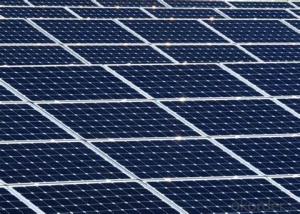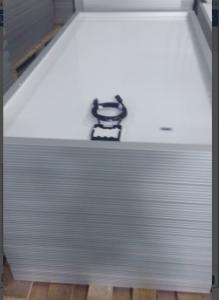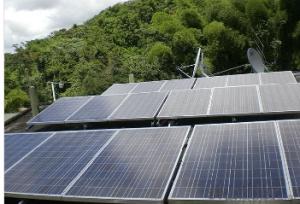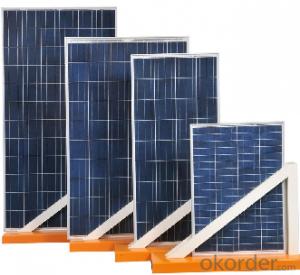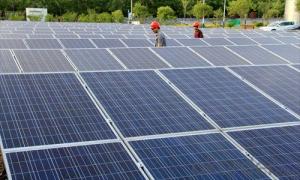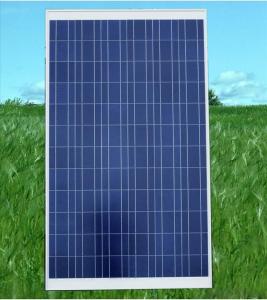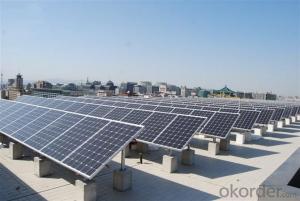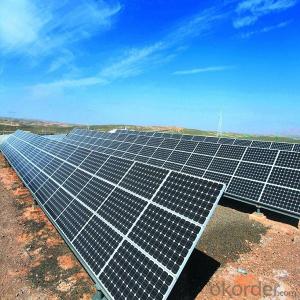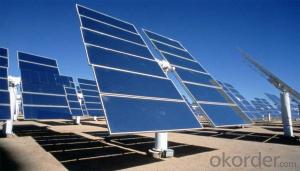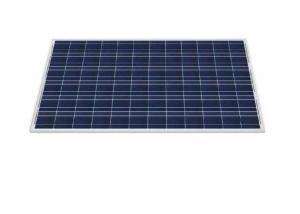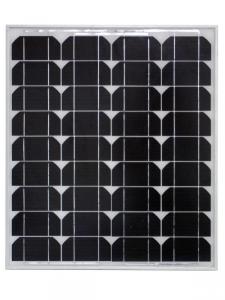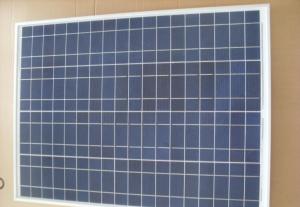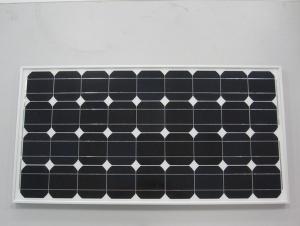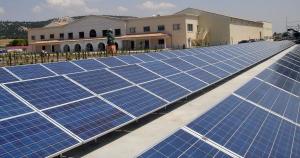Ohio Solar Panels - Polycrystalline Solar Panels 265W with High Efficiency
- Loading Port:
- China main port
- Payment Terms:
- TT OR LC
- Min Order Qty:
- 1000 watt
- Supply Capability:
- 1000000 watt/month
OKorder Service Pledge
OKorder Financial Service
You Might Also Like
Specification
Introduction of Poly solar panels CNBM
Polycrystalline Solar Panels 265W With High Efficiency
CNBM Solar photovoltaic (PV) Panel is designed for large electrical power requirements. It is the optimal choice for both on-grid and off-grid power systems. CNBM Solar panel offers high performance of power per square foot of solar array. Monocrystalline silicon(c-Si): often made using the Czochralski process. Single-crystal wafer cells tend to be expensive, and because they are cut from cylindrical ingots, do not completely cover a square solar cell module without a substantial waste of refined silicon. Hence most c-Si panels have uncovered gaps at the four corners of the cells.
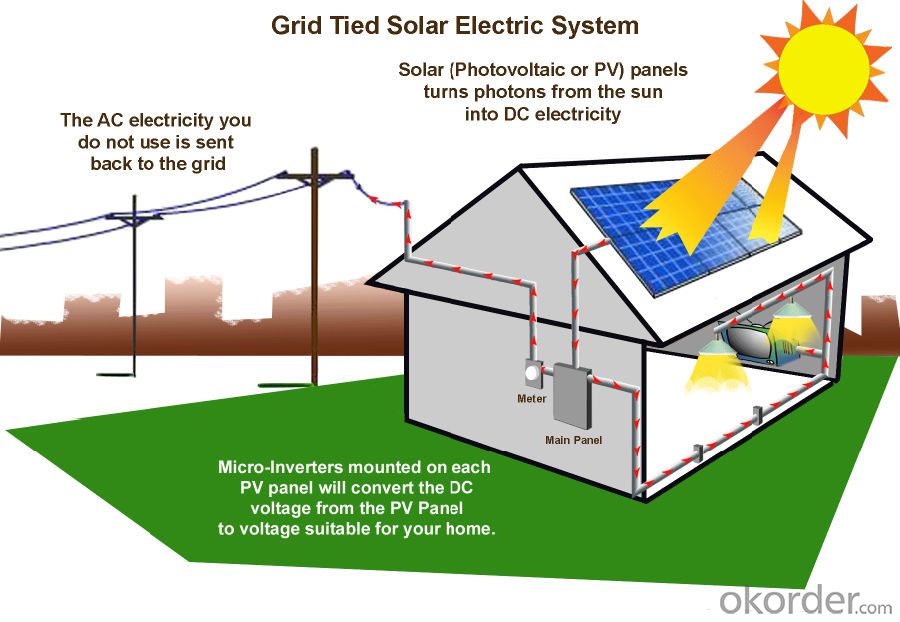
Feature
1.Solar Cell : High efficiency crystalline solar cell. Even if under the weak light, the solar module can produce maximum power output.
2.Tempered glass (toughened glass): Anti-reflecting coating and high transmission rate glass increase the power output and mechanical strength of solar module.
3.EVA and TPT: Using high quality EVA and TPT to prevent destroying and water.
4.Long lifetime: ≥25 years; Less power decrease.
5.Resisting moisture and etching effectively, not effected by geology.
6.The certificate issued by international authority: UL, TUV, IEC, VDE, CE.
Specification
Characteristics of Poly solar panels CNBM | |||||
Max Power Voltage Vmp(V) | 30.3 | 30.8 | 31.1 | 31.4 | 31.85 |
Max Power Current Imp(A) | 7.60 | 7.64 | 7.73 | 7.81 | 7.85 |
Open Circuit Voltage Voc(V) | 36.1 | 36.6 | 37 | 37.3 | 37.68 |
Short Circuit Current Isc(A) | 8.50 | 8.55 | 8.65 | 8.75 | 8.85 |
Max Power Pm(W) | 230W | 235W | 240W | 245W | 250W |
Temperature Coefficient of Cells Poly solar panels CNBM | |
NOCT | 45℃ ± 2℃ |
Temperature Coeffucients of Isc (%/℃) | 0.0492 |
Temperature Coeffucients of Voc (%/℃) | -0.3374 |
Temperature Coeffucients of Voc (%/℃) | -0.4677 |
Mechanical Data of Poly solar panels CNBM | |
Dimension | 1638 × 982 × 40 mm |
Weight | 19.5 kg |
No. of Cells and Connections | 60 (6 ×10) |
Tolerance | 0 ~ + 5 W |
Cell | Monocrystalline Cell 156 × 156 mm |
Packing | 624 Pcs/40ft(H) Container |
Limits of Poly solar panels CNBM | |
Operating Temperature | -40℃ to +85℃ |
Storage Temperature | -40℃ to +85℃ |
Max System Voltage | 1000VDC(IEC) / 600VDC(UL) |
Guarantees of Poly solar panels CNBM | |
Products Guarantee | 12 yrs free from defects in materials and workmanship |
Performance Guarantee | No less than 90% within 10yrs and no less than 80% within 25yrs |
Certificates | TUV(IEC61215&IEC61730),VDE(IEC61215&IEC61730),UL,CE |
Packaging Information
Package:26pcs/box
Quantity:1 box/pallent
Loading Capacity:952pcs/40ft
- Q: How often do solar panels need to be replaced or repaired roughly? Is it costly to do so?
- I'm okorder /... . That means that not only do they guarantee the panel won't completely die, they guarantee that it will deliver a certain amount of power. That suggests that manufacturers expect most panels to last longer than 25 years. Our panels have been up a little over 5 years - no trouble yet. In a dirty location, or where the panels are mounted flat, occasional cleaning may be required. In many place, the morning dew and slant of the panels is enough to keep them clean. In my limited experiments with our panels, I saw little difference in power production between a panel that appeared dingy to the eye, and one that was just cleaned. There is a component called an inverter used in most solar power systems. That generally has a warranty of 0 years, so expect it to break after 5, to be replaced at a cost of a few thousand dollars. Or maybe repaired for less. The kind of solar power popularly installed today does not use batteries. Batteries are generally only for remote installations that did not have grid power when the solar was first put up.
- Q: i am looking for solar panels and wind mill to put around our house and i was wondering were to find them
- From a decent solar panel store. Or you can get on the Internet and look for someone in your area.
- Q: Does a solar panel work under a full moon a tiny bit, or not at all? Likewise, if you used mirrors or lenses the concentrate sunlight, is there a maximum to how much a solar panel can handle?
- I believe solar panels gather enough energy from the sun in the daytime.I don't own one therefore I AM not a 00% sure unless it runs on batteries,generator or alternator.Who knows it just may plug up at night.
- Q: My husband is interested in buying solar panels for the roof and i dont know where to find them.
- Why pay thousands of dollars for solar energy ($27,000 average cost) when you can build your own solar panel system for just a fraction of the retail cost. You can build a single solar panel or you can build an entire array of panels to power your whole house. Some people are saving 50% on their power bill, some people are reducing their bill to nothing. But what’s most impressive is that just by following these instructions some are even making the power company pay them!
- Q: Can solar panels be installed on bus stops or shelters?
- Yes, solar panels can be installed on bus stops or shelters. This allows them to generate electricity from sunlight, which can be used to power lighting, signage, and other amenities at the bus stops or shelters. It also helps in reducing reliance on grid electricity and promotes the use of renewable energy sources.
- Q: Can solar panels be used to power a music festival?
- Yes, solar panels can be used to power a music festival. Solar panels can generate electricity from sunlight, which can be used to power various equipment and stages at the festival. By harnessing solar energy, festivals can reduce their reliance on traditional power sources and lower their carbon footprint.
- Q: Do solar panels require a battery?
- No, solar panels do not require a battery. They generate electricity directly from sunlight and can feed the excess energy back into the grid. However, a battery can be used to store the excess energy for later use when the sun isn't shining.
- Q: solar panels are way too expensive to buy, can they be homemade cheaply? i want at least 500 watts. everyone on the web sells these instructions, but i'd like a link to free info, if it is really possible for a non-sciencey person to make. thank you
- If you want long term working ones then no. I have not seen the web instructions ones, but solar panels that are manufactured are a lot more complex then simple solar panels that you make in your backyard. Also, you need to have some type of turbine or other thing to change heat energy into electrical energy. For a non science person to try and do this and have it work the first time maybe hard to accomplish.
- Q: I want to purchase some or one solar panel for my home. I don't know where to buy them from. I've loooked online and if i could buy them online that would be best, but if you knew of a website that has good prices than that would be great!Thanks
- Are you looking for the best and Affordable Solar Panels? Find and compare brands of Solar Panels for home power systems. Contact us today for more details.
- Q: i was reading the popular science magazine and i saw that they might make a Sun Powered it Absolutely NOT possible to make a car with a Solar Panel? I dont see any harm in making it..
- There are lots of cars with solar panels, but they are all experimental. The problem is that the power required to run a car is a lot more than the limited number of solar panels can produce. The sail boat can use the solar panels as sails, to get power from both.
Send your message to us
Ohio Solar Panels - Polycrystalline Solar Panels 265W with High Efficiency
- Loading Port:
- China main port
- Payment Terms:
- TT OR LC
- Min Order Qty:
- 1000 watt
- Supply Capability:
- 1000000 watt/month
OKorder Service Pledge
OKorder Financial Service
Similar products
Hot products
Hot Searches
Related keywords
